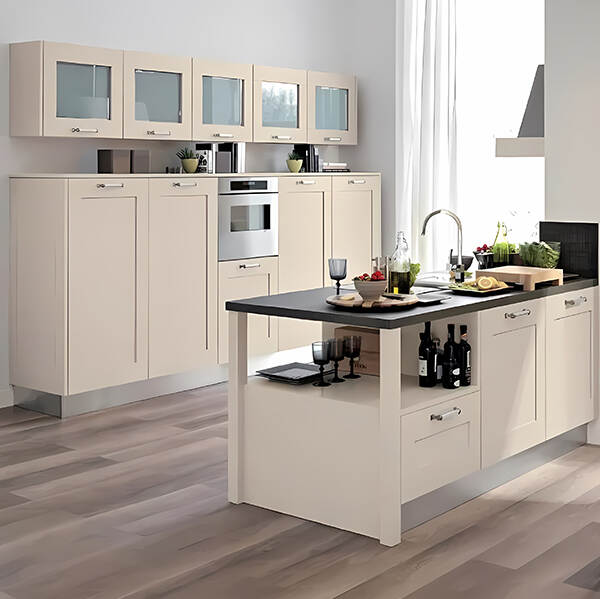
The Impact of 3D Printing on Building Materials

The construction industry is evolving rapidly, with advancements in technology reshaping the way buildings are designed and constructed. One of the most revolutionary innovations in this field is 3D printing, which has begun to significantly influence building materials. This technology offers a new approach to creating components for construction, providing opportunities for efficiency, customization, and sustainability that traditional methods often struggle to achieve.
In this context, Y&R Furniture stands out as a mature custom kitchen cabinet manufacturer and bathroom vanity factory with over 25 years of experience in the building material industry across Asia. We serve clients from more than 20 countries, providing comprehensive solutions tailored to various project requirements. As the landscape of building materials transforms through the influence of 3D printing, companies like ours are poised to explore new material combinations and innovative designs that meet the demands of modern construction and design aesthetics.
Overview of 3D Printing in Construction
3D printing, also known as additive manufacturing, has emerged as a transformative technology in the construction industry. This process involves creating three-dimensional objects layer by layer from a digital model, which allows for the use of a wide variety of materials. In recent years, construction companies have begun to explore how 3D printing can be applied to create building structures, components, and even intricate design features. This innovation not only enhances efficiency but also opens up new possibilities for customization and complexity in architectural design.
One of the most significant advantages of 3D printing in construction is its potential to reduce waste and lower costs. Traditional building methods often involve significant material waste, whereas 3D printing can optimize material usage by producing only what is needed for each project. Additionally, the speed of 3D printing allows for quicker project completion times, which can be particularly beneficial in meeting construction deadlines and responding to urgent housing needs, especially in areas impacted by natural disasters.
As the technology continues to evolve, various materials are being developed specifically for 3D printing applications in construction. These include concrete mixtures, polymers, and composites that can enhance durability and performance. Companies like Y&R Furniture, with their extensive experience in the custom building materials sector, can leverage these advancements to create innovative products such as kitchen cabinets and bathroom vanities. By integrating 3D printing into their manufacturing processes, they can offer more customization options while maintaining efficiency and quality in their offerings.
Benefits of 3D Printing for Building Materials
3D printing technology has revolutionized the building materials industry by enabling manufacturers to produce customized components rapidly and efficiently. Unlike traditional manufacturing processes that often involve extensive lead times and significant waste, 3D printing allows for on-demand production. This means that materials can be created as needed, reducing inventory costs and minimizing excess production. Custom kitchen cabinets and bathroom vanities, for instance, can be tailored to specific project requirements without the complications of conventional manufacturing.
Additionally, 3D printing facilitates the use of innovative materials that can enhance the performance and sustainability of building products. The ability to experiment with composite materials and bio-based substances can lead to more environmentally friendly solutions. For a mature custom kitchen cabinet manufacturer like Y&R Furniture, integrating 3D printing into their workflow can result in not only improved aesthetics but also functionality, ensuring their offerings meet the evolving demands of customers in diverse markets.
Moreover, the design flexibility inherent in 3D printing encourages creativity in building design. Architects and designers are empowered to explore complex geometries and structures that were previously challenging or impossible to achieve. This opens new possibilities for creating unique and efficient products, allowing builders to stand out in a competitive market. As a result, embracing 3D printing can provide a significant competitive edge for companies like Y&R Furniture, enhancing their reputation and ability to serve clients in over 20 countries with innovative and tailored solutions. As the construction industry evolves with advancements like 3D printing, homeowners are increasingly turning to platforms for Bathroom Vanity Online Shopping to find stylish and modern fixtures for their renovated spaces.
Case Studies of 3D Printed Projects
One notable case study in the realm of 3D printed building materials is the use of additive manufacturing in the construction of homes in Europe. A project in the Netherlands showcased the capability of 3D printing technology to construct entire houses in just days. Utilizing a concrete-like mixture, the printers were able to create complex designs that would be challenging and time-consuming with traditional construction methods. This innovation not only reduced construction time significantly but also minimized waste, aligning with sustainable building practices.
In the United States, a team of architects and engineers completed a stunning 3D printed community center in Austin, Texas. This project demonstrated the versatility of 3D printing to produce both structural and decorative elements with precision. By integrating advanced design software with 3D printing capabilities, the team was able to push the boundaries of architectural aesthetics while maintaining structural integrity. The resulting building has become a model for future projects that seek to blend technology with innovative design.
Asia has also seen exciting developments, particularly with collaborative efforts that combine 3D printing with local materials. In a recent initiative, a consortium of builders partnered with local artisans to create custom building components for modular homes. This project emphasized local craftsmanship while leveraging the efficiency of 3D printing, showcasing how modern techniques can enhance traditional building practices. The outcome was a series of eye-catching modular units that attracted attention for their unique designs and swift assembly processes.
Future Trends in 3D Printing and Construction
As 3D printing technology continues to evolve, its integration into the construction industry is gaining momentum. One significant trend is the increasing use of sustainable materials. Companies are exploring bio-based and recycled materials for 3D printing, which not only reduce waste but also minimize the carbon footprint associated with traditional building methods. This shift towards sustainability aligns with the growing demand for eco-friendly construction practices and could redefine the way builders and manufacturers approach material sourcing.
Another emerging trend is the customization capability that 3D printing offers, particularly for companies like Y&R Furniture, known for its custom kitchen cabinets and bathroom vanities. Builders can create unique, tailored structures or components that perfectly fit specific design requirements, enhancing aesthetic appeal and functionality. This level of customization allows for innovative designs that meet the diverse needs of clients, ultimately transforming how spaces are conceptualized and constructed.
Furthermore, the potential for on-site construction using 3D printers is set to revolutionize the industry. By enabling rapid production of building materials directly at the construction site, projects can be completed faster and with fewer logistical challenges. This trend not only reduces transportation costs but also enhances coordination between different construction phases. As technology advances, we can expect 3D printing to play a crucial role in shaping the future of the building materials sector, driving efficiency and opening up new possibilities for builders and manufacturers alike.



